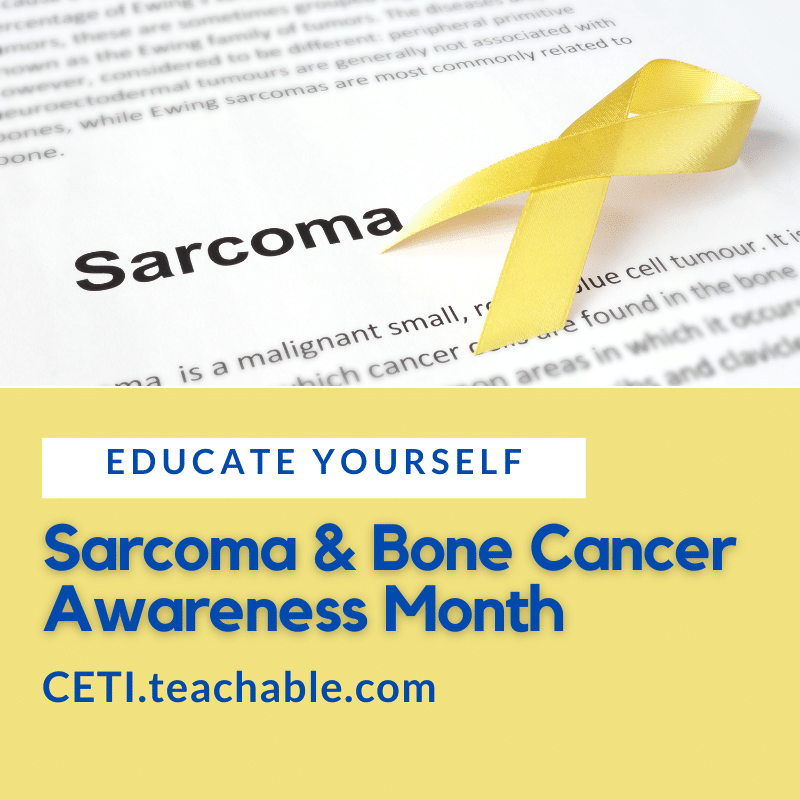July is Bone & Sarcoma Awareness Month
Sarcomas are a rare group of cancers in which malignant cells form in the bones or soft tissues of the body.
Soft tissue sarcomas form in cartilage, fat, muscle, blood vessels, tendons, nerves, and around joints. Osteosarcomas develop in bone; liposarcomas form in fat; rhabdomyosarcomas form in muscle; and Ewing sarcomas form in bone and soft tissue.
Bone and joint cancer is most frequently diagnosed among teenagers, while soft tissue cancers typically affect those 55 years or older.
In 2021, more than 13,000 cases of soft tissue sarcoma and approximately 3,600 cases of bone sarcoma are expected to be diagnosed in the United States, according to data from the National Cancer Institute’s Surveillance, Epidemiology, and End Results Program (SEER). Some 5,350 and 2,060 people are expected to die from soft tissue and bone sarcomas, respectively. The five-year survival rate for soft tissue sarcomas is 65.0 percent, while the survival rate is 66.8 percent for bone sarcomas.
Because sarcomas are difficult to distinguish from other cancers when they are found within organs, their incidence is probably underestimated, according to the National Cancer Institute.
Having certain inherited disorders can increase the risk for soft tissue sarcomas, including retinoblastoma, tuberous sclerosis, Werner syndrome, and nevoid basal cell carcinoma syndrome. Other risk factors for soft tissue sarcomas include past treatment with radiation therapy for certain cancers; exposure to certain chemicals, such as thorium dioxide, vinyl chloride, or arsenic; and long-term lymphedema in the arms or legs.
Past treatment with radiation can increase the risk of osteosarcoma and other types of bone cancers. Other risk factors for osteosarcoma include treatment with anticancer drugs called alkylating agents, having a certain change in the retinoblastoma gene, and having certain conditions including Paget disease, Diamond-Blackfan anemia, and Werner syndrome.
Soft tissue sarcomas form in cartilage, fat, muscle, blood vessels, tendons, nerves, and around joints. Osteosarcomas develop in bone; liposarcomas form in fat; rhabdomyosarcomas form in muscle; and Ewing sarcomas form in bone and soft tissue.
Bone and joint cancer is most frequently diagnosed among teenagers, while soft tissue cancers typically affect those 55 years or older.
In 2021, more than 13,000 cases of soft tissue sarcoma and approximately 3,600 cases of bone sarcoma are expected to be diagnosed in the United States, according to data from the National Cancer Institute’s Surveillance, Epidemiology, and End Results Program (SEER). Some 5,350 and 2,060 people are expected to die from soft tissue and bone sarcomas, respectively. The five-year survival rate for soft tissue sarcomas is 65.0 percent, while the survival rate is 66.8 percent for bone sarcomas.
Because sarcomas are difficult to distinguish from other cancers when they are found within organs, their incidence is probably underestimated, according to the National Cancer Institute.
Having certain inherited disorders can increase the risk for soft tissue sarcomas, including retinoblastoma, tuberous sclerosis, Werner syndrome, and nevoid basal cell carcinoma syndrome. Other risk factors for soft tissue sarcomas include past treatment with radiation therapy for certain cancers; exposure to certain chemicals, such as thorium dioxide, vinyl chloride, or arsenic; and long-term lymphedema in the arms or legs.
Past treatment with radiation can increase the risk of osteosarcoma and other types of bone cancers. Other risk factors for osteosarcoma include treatment with anticancer drugs called alkylating agents, having a certain change in the retinoblastoma gene, and having certain conditions including Paget disease, Diamond-Blackfan anemia, and Werner syndrome.
This information is provided to you by the American Association for Cancer Research

